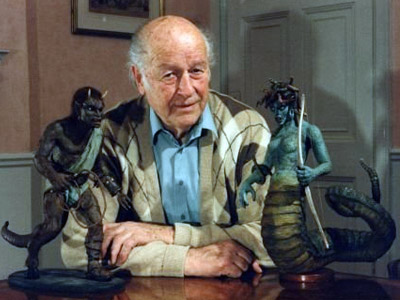
Ray Harryhausen is the acknowledged master of stop-motion animation. His work on movies like The Seventh Voyage of Sinbad and Jason and the Argonauts inspired almost everyone else who ever tried to animate three-dimensional figures, whether it was on major 35mm features done in Hollywood or little 8mm attempts done in some teenager's garage. Mr. Harryhausen himself started in his garage in Hollywood, working in 16mm, learning his craft by experimentation, which is really the only way you can learn that kind of thing. Last night at the Motion Picture Academy, a good sampling of the animation business gathered to hear him interviewed by Leonard Maltin, and to see some of that earliest trial-and-error work.
It was amazing how few errors were visible in it, even with the films enlarged to 35mm for the Academy's screen. (Well, visible to us. Ray kept talking about how many flaws he now saw in films he made over a half-century ago.)
Those who associate him only with animating dinosaurs and skeleton creatures would have been fascinated to see what made up the bulk of the program last night. Beginning in the forties, Harryhausen animated — still in his garage — a series of short fairy tales for what was then called the non-theatrical market, meaning schools and rental agencies. The Academy arranged for major restoration work to be done on the films, and the prints were stunning. This material has been available in home video in the past, but a forthcoming DVD of the restored versions will soon be out, perhaps as early as late this year. It is quite fascinating, especially when viewed in chronological order, allowing you to see Harryhausen become more ambitious and more facile in bringing life to the beautiful little figures he designed and built.
The audience was like a Who's Who of the animation field. (I sat next to June Foray, who had just come from recording voice tracks for a new Rocky and Bullwinkle slot machine.) Mr. Harryhausen seemed genuinely humbled by the turnout and passion for his work, and I think a lot of those in attendance sensed a direct correlation between the film and the filmmaker. Stop-motion animation requires an incredible devotion to detail, and nothing occurs by accident. After hearing Ray Harryhausen talk about his craft, I think everyone understood why it all turned out as well as it did, and why he was always striving to outdo himself. A lovely time.